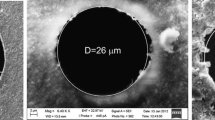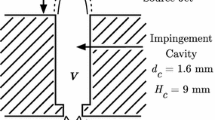Abstract
Miniature axisymmetric supersonic nozzles were produced with exit Mach numbers ranging from 1.0 to 2.8 by forming Pyrex® capillary tubing of 0.6 and 1.2 mm inside diameter into converging-diverging channels. The nozzle contours were measured and were found to compare favorably to ideal solutions given by the axisymmetric method of characteristics. In addition, the surfaces of these nozzles were quite smooth, providing featureless flows at perfect expansion. Schlieren visualization and pitot pressure measurements of the resulting microjets were compared to the literature available for jets produced by larger-scale nozzles. A postponed transition to turbulence is noted in these microjets due to their low Reynolds number. The pitot pressure on centerline is nearly uniform at perfect expansion over core lengths up to 12 nozzle exit diameters. Supersonic microjet nozzles thus provide a more effective small-scale high-pressure gas delivery device than do sonic nozzles of comparable scale at equivalent mass flow rates. Supersonic microjets may therefore have several industrial applications.
Similar content being viewed by others
Abbreviations
- δ* :
-
boundary layer displacement thickness, mm
- d :
-
diameter of nozzle exit, mm
- L :
-
length of nozzle diverging section, mm
- L c :
-
inviscid core length, mm
- L s :
-
supersonic region length, mm
- M c :
-
convective Mach number
- M e :
-
exit Mach number
- P b :
-
backpressure at nozzle exit, (equal to ambient pressure in this experiment)
- P e :
-
exit pressure of the supersonic jet
- P be :
-
exit pressure ratio (P b /P e )
- P p :
-
impingement pressure (pitot pressure)
- P 0 :
-
stagnation pressure supplied to nozzle
- P n :
-
overall pressure ratio (P 0/P b ,)
- r :
-
radial dimension (cylindrical coordinate system), mm
- r 0 :
-
radius of throat, mm
- Re d :
-
Reynolds number, based on nozzle exit diameter
- V e :
-
exit velocity, m/s
- x :
-
axial dimension (cylindrical coordinate system), mm
References
Adamson T; Nicholls J (1959) On the structure of jets from highly underexpanded nozzles into still air J. Aero/space Sci. Jan 16–24
Carroll BF; Dutton JC; Addy AL (1986) NOZCS2: A computer program for the design of continuous slope supersonic Nozzles. University of Illinois at Urbana-Champaign, Report No. UILU ENG 86-4007
Donaldson C; Gray KE (1966) Theoretical and experimental investigation of the compressible free mixing of two dissimilar gases. AIAA J 4: 2019–2028
Donaldson C; Snedeker R (1971) A study of free jet impingement. J Fluid Mech 45: 281–319
Fourgette DC; Mungal MG; Dibble RW (1991) Time evolution of the shear layer of a supersonic axisymmetric jet AIAA J 29: 1123–1130
Hu T; McLaughin D (1990) Flow and acoustic properties of low Reynolds number underexpanded supersonic jets. J of Sound and Vibration 141: 485–505
Jindra KJ (1970) Geometric effects on the performance characteristics of very small nozzles. Masters Thesis, Air Force Inst. of Tech., Wright-Patterson AFB, Ohio School of Engineering, Dec.
John JEA (1984) Gas dynamics. 2 ed., New York: Prentice Hall
Merzkirch W (1987) Flow visualization, 2 ed. Orlando: Academic Press
Morrison GL; McLaughlin DK (1980) Instability process in low Reynolds number supersonic jets. AIAA J 18: 793–800
Novopashin SA; Perepelkin AL (1988) Axial symmetry loss of a preturbulent jet. Phys Lett 135: 290–293
Novopashin SA; Perepelkin AL (1992) Transition to turbulence in a supersonic jet. Russian J Eng Thermophys 2: 51–61
Nagamatsu HT; Sheer RE (1969) Supersonic jet noise theory and experiments. NASA SP-207
Prandtl L (1952) The essentials of fluid dynamics. Glasgow: Blackie & Son
Sherman PM; Glass DR; Duleep KG (1976) Jet flowfield during screech. Appl. Scient. Res. 32: 283–303
Zapryagaev VI; Solotchin AV (1991) Three-dimensional structure of flow in a supersonic underexpanded Jet. J Appl Mech Tech Phys 32: 503–507
Author information
Authors and Affiliations
Additional information
This research was sponsored by National Science Foundation Grant DMI 9400119, as part of a study of the assist-gas dynamics of laser cutting.
Rights and permissions
About this article
Cite this article
Scroggs, S.D., Settles, G.S. An experimental study of supersonic microjets. Experiments in Fluids 21, 401–409 (1996). https://doi.org/10.1007/BF00189042
Received:
Accepted:
Issue Date:
DOI: https://doi.org/10.1007/BF00189042




